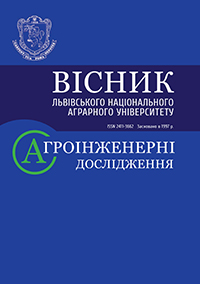REVIEW OF REOLOGICAL MODELS
DOI:
https://doi.org/10.31734/agroengineering2018.01.022Keywords:
strain, deformation, relaxation, rheology, rheological models, Hooke's body, Newton's bod, Saint-Venant's-Coulomb bodyAbstract
Foodstuffs during harvesting, transportation, storage, especially during processing are subject to various mechanical influences. In this case, the production processes should be organized in such a way as to ensure the highest possible level of quality of finished products. A successful solution to this problem is the knowledge of rheological properties and texture of food products. Food products, including raw materials and semi-finished products, vary by their composition, disperse composition and structure, with different rheological properties with texture distinctive features.
The article analyzes both elementary rheological models such as the model of Hooke (perfectly elastic body), Newton (perfectly viscous body) and Saint-Venant – Coulomb (ideally plastic body) as well as other more complex combinations of these elementary rheological models such as as the model of Maxwell, Kelvin –Voigt, Ziner, Prandtl, Bingham and others. Examples of their use are also given.
Biological agricultural materials have a complex multilayered rheological structure. Preferably, each of these layers has its own, different from other properties. Therefore, for a more precise description of the behavior of biological agricultural materials during transportation, and the process of processing, and in particular in the interaction with the working bodies of cars, it is necessary to study in detail the rheological structure of these materials.
In order to adequately describe the rheological properties of agricultural materials, it is necessary to use models consisting of three or more elements. However, with increasing number of elements, not only the precision of the description of a particular biological material increases, but also their mathematical analysis becomes much more complicated.
References
Aret V. A., Nikolaev B. L., Nikolaev L. K. Fiziko-mekhanicheskie svojstva syr'ya i gotovoj produkcii. Sankt-Peterburg: GIORD, 2009. 448 s.
Artemchuk V. V. Reolohichni vlastyvosti bahatosharovykh materialiv. Visnyk Dnipropetrovskoho natsionalnoho universytetu zaliznychnoho transportu imeni akademika V. Lazariana. 2011. Vyp. 37. S. 20–25.
Bagtenev G. M., Frenkel' S. Ya. Fizika polimerov / pod. red. d-ra fiz.-mat. nauk A. M. El'yashevicha. Leningrad: Himiya, 1990. 4323 s.
Bohomolov V. O., Zhdaniuk V. K., Riapukhin V. M., Bohomolov S. V. Reolohichna model roboty asfaltobetonu pry styskanni. Avtoshliakhovyk Ukrainy. 2010. № 3. S. 34–37.
Kovbasa V. P. Mekhaniko-tekhnolohichne obgruntuvannia optymalnoi vzaiemodii robochykh orhaniv z gruntom: avtoref. dys. … d-ra tekhn. nauk. Kyiv, 2006. 35 s.
Konstruirovanie i raschet nezhestkih dorozhnyh odezhd / pod red. N. N. Ivanova. Moskva: Transport, 1973. 328 s.
Kostrzhytskyi A. I., Kalinkov O. Yu., Tishchenko V. M., Berehova O. M. Fizychna ta koloidna khimiia: navch. posib. Kyiv: Tsentr navch. lit., 2008. 496 s.
Kuznecov O. A., Voloshin E. V., Sagitov R. F. Reologiya pishchevyh mass: ucheb. posobie. Orenburg: GOU OGU, 2005. 106 s.
Palamarchuk I. P., Yanovych V. P., Kupchuk I. M. Doslidzhennia reolohichnykh kharakterystyk zernovoi krokhmalevmisnoi syrovyny spyrtovoho vyrobnytstva. Tekhnika, enerhetyka, transport APK. 2016. № 3 (95). S. 130–134.
Rejner M. Reologiya. Moskva: Nauka, 1965. 223 s.
Shul'man Z. P., Kovalev Ya N., Zal'cindler E. A. Reofizika konglomeratnyh materialov. Minsk: Nauka i tekhnika, 1978. 240 s.
Ji S., Shen H. H. Contact Force Models for Granular Flows. Report No. 04-02. Potsdam; New York: Department of Civil and environmental engineering. Clarkson University, 2004. Р. 3699–5710.
Lord Kelvin (Sir W. Thomson) «Elasticity» Encyclopedia Britannica. 9th ed. London, 1875.
Mainardi F., Gorenflo R. Time-fractional derivatives in relaxation processes: a tutorial survey. Fractional Calculus and Applied Analysis. 2007. Vol. 10, No. 3. P. 269–308.
Marynowski K., Kapitaniak T. Kelvin-Voigt versus Bürgers internal damping in modeling of axially moving viscoelastic web. International Journal of Non-Linear Mechanics. 2002. 37. P. 1147–1161.
Moczo P., Kristek J., Franck P. Lecture Notes on Rheological Models. DAPEM FMPI CU. 2006. 40 p.
Renaud F., Dion J.-L., Chevallier G., Tawfiq I., Lemaire R. A new identification method of viscoelastic behavior: Application tothe generalized Maxwell model. Mechanical Systems and Signal Processing, Elsevier. 2011. 25. P. 991–1010.
Shahsavari R., Ulm F.-J. Indentation analysis of fractional viscoelastic solids. Journal of mechanics of materials and structures. 2009. Vol. 4, No. 3. P. 523–550.
Wicek J., Molenda M. Moisture-dependent physical properties of rapeseed – experimental and DEM modeling. International Agrophysics. 2011. 25. P. 59–65.
Xiao R., Sun H., Chen W. An equivalence between generalized Maxwell model and fractional Zener model. Mechanics of Materials. 2016. 100. P. 148–153.


